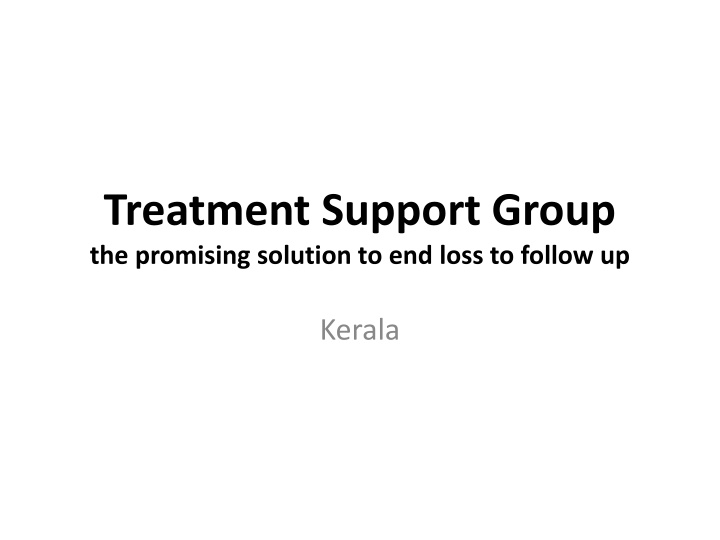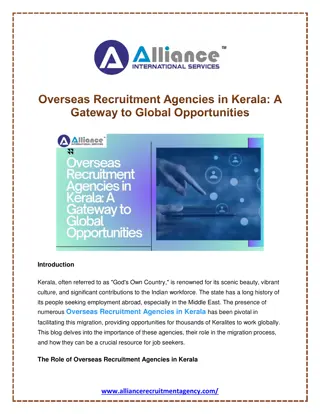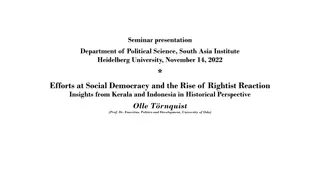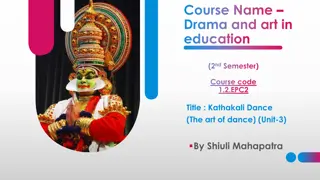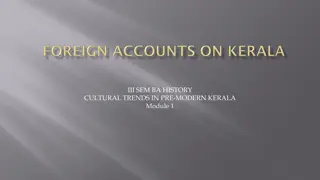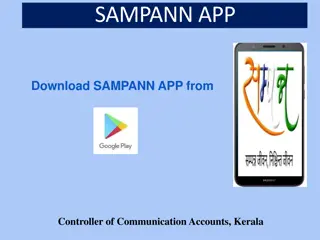Innovative Approach to Address Loss to Follow Up in Kerala
This presentation showcases the successful implementation of the Treatment Support Group strategy in Kerala's Pathanamthitta district to combat the issue of Loss to Follow Up (LFU) among tuberculosis patients. Through the reengineering of DOTS and the establishment of Treatment Support Groups, the district has seen a significant reduction in LFU rates, especially among New Smear Positives. Detailed analysis of the trends and strategies employed are presented, highlighting the effectiveness of the DOTS Triad concept and the operational success of the Treatment Support Group since 4th quarter of 2011.
Download Presentation

Please find below an Image/Link to download the presentation.
The content on the website is provided AS IS for your information and personal use only. It may not be sold, licensed, or shared on other websites without obtaining consent from the author.If you encounter any issues during the download, it is possible that the publisher has removed the file from their server.
You are allowed to download the files provided on this website for personal or commercial use, subject to the condition that they are used lawfully. All files are the property of their respective owners.
The content on the website is provided AS IS for your information and personal use only. It may not be sold, licensed, or shared on other websites without obtaining consent from the author.
E N D
Presentation Transcript
Treatment Support Group the promising solution to end loss to follow up Kerala
This presentation will highlight Decreasing trend of LFU in Kerala Pathanamthitta district reporting zero default Reengineering of DOTS to DOTS Triad Concept and functioning of Treatment Support Group [TSG] strategy
Annual trend of ILFU and LFU among TB cases in Kerala % ILFU % NSP LFU % RT+ LFU 14.2% 13.6% 13.1% 12.3% 11.1% 10.9% Proportion of cases lost to FU 6.2% 5.7% 5.5% 5.2% 4.9% 4.3% 4.6% 4.5% 4.0% 3.5% 3.5% 3.1% Y2010 Y2011 Y2012 Y2013 Y2014 Y2015
Number of TUs reporting Zero LFU among NSP in Kerala Quarter Yr Number of TUs with Zero LFU Proportion of TUs with zero LFU Proportion of population with zero LFU 1q14 14 19.2% 18.3% 2q14 25 34.2% 29.0%
Annual trends of Loss to Follow Up in Pathanamthitta district, Kerala ILFU among all Diagnosed S+ LFU among New Smear Positives 8.0% 4.0% Proportion of cases lost to FU 7.0% 3.5% 6.0% 3.0% 5.0% 2.5% 4.0% 2.0% 3.0% 1.5% 2.0% 1.0% 1.0% 0.5% 0.0% 0.0% Y2008Y2009Y2010Y2011Y2012Y2013Y2014 Y2008Y2009Y2010Y2011Y2012Y2013Y2014
Background of LFU in Pathanamthitta Implementing RNTCP as a pioneer district since 1993. Moderately hilly district that nests 1.2 million population with a density of 452/sq.km, Urban segment is 11% and adult literacy rate is 97%. Reasonable access to health care services including TB care. Quarterly they test 4000 presumptive TB cases, diagnose175 smear positive cases, register 300 TB cases of which 150 are NSP. 3.5% of diagnosed S+ are ILFU and 6% of NSP are LFU during treatment. Attempts based on reengineering of DOTS resulted in considerable reduction in LFU; however, the last mile remained to be highly challenging
Re-engineering DOTS [1/2] Re-engineering DOTS was based on a concept called DOTS triad. A DOTS triad is a three way Patient DOT Provider transaction among the patient, DOTS Triad DOT provider and a representative of health system, who is a multipurpose health worker [MPHW] at PHC for MPHW every 5,000 population.
DOTS Triad functioning Operational since 4q11. MPHW (not STS) is primarily accountable for each case in his jurisdiction. Most of the DOT providers are community volunteers (ASHA, SHG, next door neighbours) MPHW does the initial home visit, counselling and contact tracing. MPHWs are trained in counselling (Axshaya) Fortnightly follow up visit to patient & DP. Updating cards follows. Early detection of ADRs and retrieval of interrupters. MPHS (not STS) supervises and the designated block MO (not MOTC) reviews the process fortnightly. DMO (assisted by DTO) reviews PHC wise monthly on every 5th working day.
Advantages over classic RNTCP DOT Absolute integration with general health system at the most peripheral level Vertical HR (MOTC, STS) are freed for focussed activities (trainings, migrants, anti-tobacco, PPM, QA of DOT, notification )
The last mile sprint Though DOTS Triad reduced LFU to a great extend, a small proportion did not adhere to treatment. Reasons were alcohol/drug addiction, broken family, destitute, difficult access to DOT centre, inadequate food, lack of sense of social inclusion. DOTS triad had casual relationship with initial loss since its function commences with treatment initiation A new concept, the Treatment Support Group (TSG) was implemented to mop the floor clean
Concept of TSG A treatment support group [TSG] is a non-statutory body of socially responsible citizens and volunteers to provide social support to each needy TB patient safeguarding his dignity and confidentiality by ensuring access to information, free and quality services and social welfare programs, empowering the patient for making decision to complete the treatment successfully.
Organization of TSG The group is usually chaired by the president of Gram Panchayat, its health standing committee chairperson or a local opinion leader. Members of the group are the MO, MPHW, community DOT provider, experienced informal counsellors, CBO or FBO members, Janamythri police (citizen-friendly police), local philanthropists and other community volunteers. The group supports all the DOTS triads in its sphere of influence. Though this is an informal group, they have started formal meetings and documentation recently.
Formation of TSG MO/MPHS meets potential members One opening meeting of all members Linkage of patient with TSG is through MPHW Documentation by MPHW Conveniently held TSG meetings approximately once in a quarter
TSG: The protective hands Patient DOT Provider DOTS Triad MPHW
Functioning of TSG Functional since 1q13. Dignity and confidentiality of the patient rank high in priority Hence only needy patients are linked to TSG through MPHW. This linkage is with patients consent. Examples of linkages TB pension from revenue department Food support to the family by gram panchayat Travel support by gram panchayat/ philanthropist House visit by FBO member House visit by counsellor Retrieval of interrupters Friendly house visit by a Janamythri police Palliative care to seriously ill TB/DRTB patients
Resources for TSG The model does not burden the health system for additional resources. Camaraderie, the most valuable resource, is the cheapest and most universal. Nutritional support through the district Panchayat s project [LSG dept]. A TB pension is provided at Rs 1000 per month till the completion of treatment [Revenue dept] Hospital expenditures through RSBY. Travel to DOT centre through local resources Travel to DRTB centre [taxi/ambulance] by LSG In rare occasions, LSG has adopted family of TB patient
